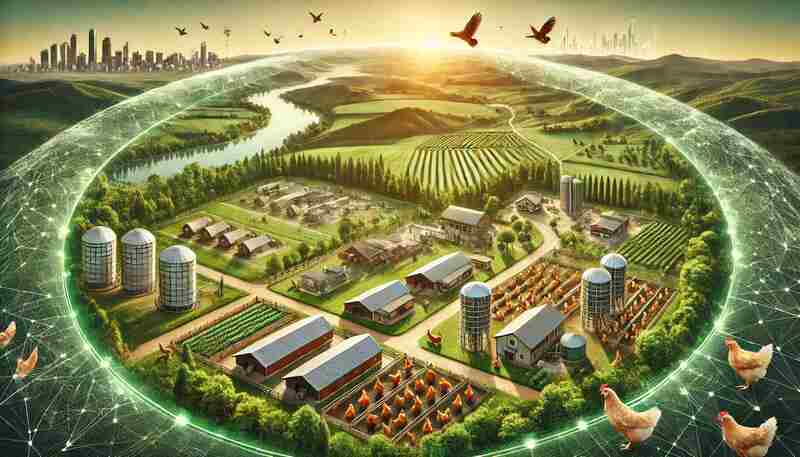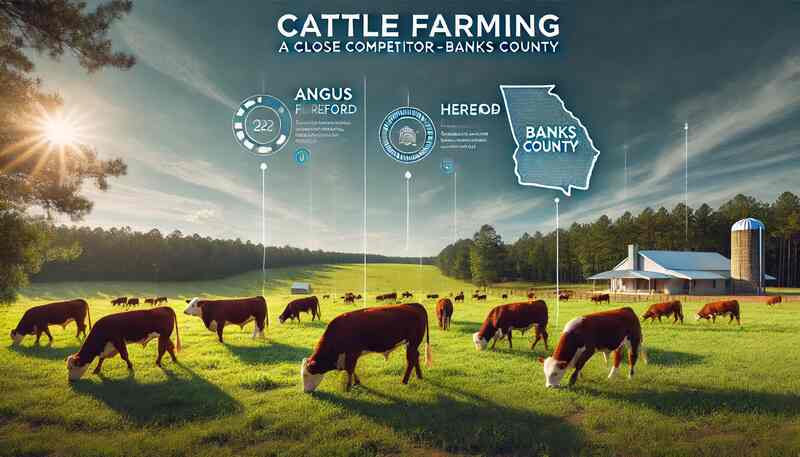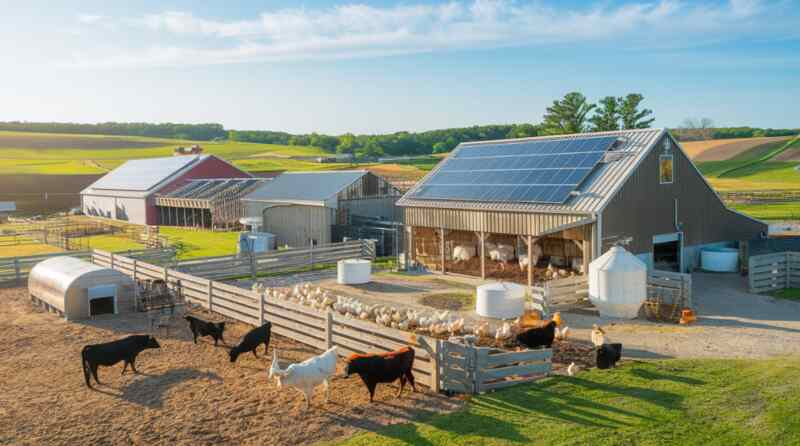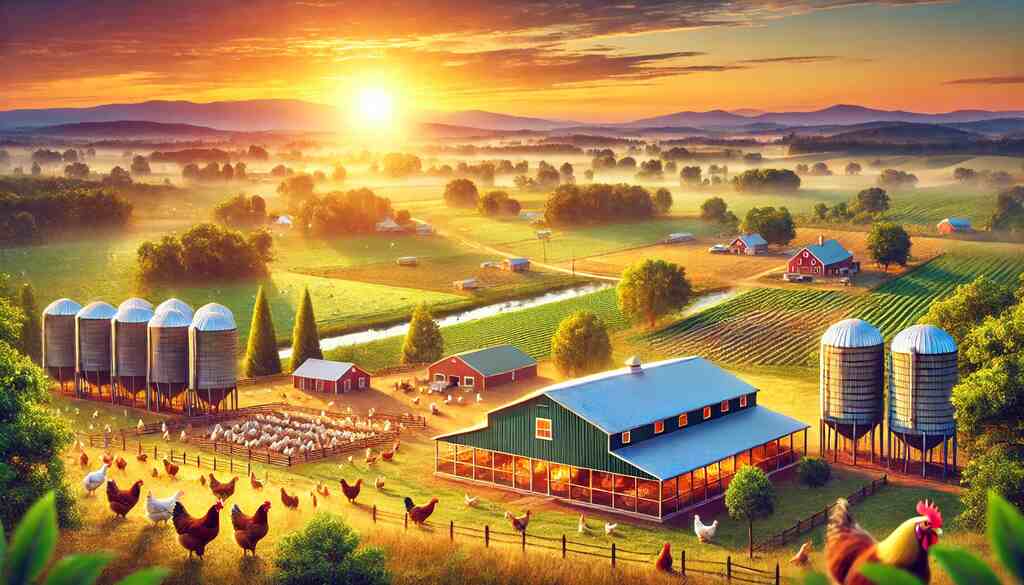This would enable one to understand the most significant livestock species in Banks County, Georgia, which is very important for investment to make that investment sustainable. Such analyses also shed light on the key role players in the county’s agricultural setup and thereby a pathway to informed and profitable decision-making by stakeholders.
Table of Contents
ToggleAgricultural Overview of Banks County, GA
Agricultural traditions are rich in Banks County, Georgia. Its mild climate combined with rich soil makes this an ideal place for a variety of farming. Agriculture is one of the strong points of the economy, livestock farming is taken as central to the rural identity of the country.
By far, most often, Banks County’s livestock production includes several species of cattle, poultry, and swine. All these industries combined make the whole economy a very important source of family income. Of course, poultry is a winner, as the greater contribution of Georgia in general to the United States is one of the leading poultry-producing states. On the other hand, beef cattle enterprises are slightly more thriving, with increasing interest in the use and development of sustainable livestock production methodologies.
Prevalent factors that will affect the prominent livestock in Banks County are market demand, available resources, and government policy promoting sustainable farming. Through all the economic ups and downs, farmers in this area usually learn to live with them; most of them usually diversify their operations so that they continue making a profit. The dynamism of this kind offers unique opportunities for investment in livestock farming.
The further we delve, the more important it is to identify the species of livestock dominating the county and what makes them lucrative investment options.
What is the Highest Livestock Species in Banks County GA?
Poultry is the highest species of livestock in Banks County. This sector outranks any livestock sector in Banks County when it comes to production numbers and financial impact.
Poultry farming is the dominant type because Georgia stands out as one of the leading producers in the United States. The county produces broiler chickens, mostly for meat production. The integrators, in most cases, are Tyson Foods and Pilgrim’s Pride, who normally subcontract from the locals, hence a system that is vertically integrated, where production, processing, and distribution are coordinated continuously.
Several reasons explain the prevalence of poultry farming. First is the fact that most climatic factors are suitable in this region for the rearing of chickens throughout the year. Secondly, technological advancement has allowed mainly efficient housing and feeding systems that minimize costs while maximizing output. Lastly, market demand, both domestically and internationally for chicken is to date high enough to ensure steady revenues for farmers.
While poultry leads, cattle farming follows closely. Most farming in Banks County has introduced beef cattle into their poultry farms, primarily Angus and Hereford breeds. However, considering the volume of production and market relations, poultry is still the topmost species within the county.
Investors looking for sustainable agriculture investment will find it useful to understand the dynamics of poultry farming in Banks County; the sector is resilient, considering the infrastructure, access to markets, and know-how.
Economic Impact of Poultry Farming in Banks County
The poultry industry is enormously significant to Banks County, providing jobs for many, opening auxiliary industries, and contributing broadly to taxes.

With employment ranging from farming, processing, and distribution, poultry is one of the leading industries in Banks County. Many families depend directly on this industry for their livelihood. Besides the direct employees, these industries support feed suppliers, equipment manufacturers, and veterinary services.
Economic benefits further trickle down to the infrastructural development potential. There could be value additions to roads and utilities in a bid to facilitate both the transportation and processing of poultry products. On the fiscal side, local governments gain a windfall of taxes owed by such investments, which thereby get reinvested into community services.
Poultry exports from Banks County add to Georgia’s reputation concerning global trade. The state has continuously been listed among the top exporters of poultry, with their products finding markets in Asia, Europe, and the Middle East. This demand in the global market increases financial stability for poultry farming in the area.
Poultry farming presents a very well-documented history of profitability regarding investment into more sustainable enterprises. From such a perspective, the currently established presence in the market and continuous technological development create a very stable and profitable investment opportunity for those looking to engage in Banks County agriculture.
Cattle Farming: A Close Competitor in Banks County
While poultry still holds the lead, cattle farming is also an important part of the agricultural setup in Banks County. Several cattle-raising farms exist within the county; most have initially engaged in rotational grazing, among other sustainable ways, in rearing cattle.

Cattle farming provides an avenue of diversification for farmers. Beef cattle production would support poultry farming, as it would utilize pastureland areas unsuitable for other crops. It offers a very dependable source of income, especially with the growth in demand for grass-fed and organic beef because of health-conscious consumers.
Key breeds of cattle in Banks County include Angus, hard to beat for marbling and taste, and Hereford, known for adaptability and ease of management. Many producers are engaged in cooperative efforts, which enhance their ability to market cattle and better reach favorable prices and expanded markets.
The fluctuating cost of feed, along with vulnerability to changes in demand from the market, is only a small segment of challenges that today’s cattle farmers must deal with. While improved genetics and nutrition management have raised productivity and profitability, there are still courses taken. Federal and state programs also provide farmers with resources as they transition to farming practices that affect the environment more positively, influencing a rising tide of consumer preference.
Though not as huge, comparatively speaking, as poultry, cattle farming contributes a fortune to the economy and presents some good sustainable investment opportunities in Banks County.
Contribution of Sustainable Farming Practices Towards Livestock Production
Sustainability has lately become an important aspect of the livestock industry in Banks County. The aspect of transparency and eco-friendly demands by consumers has basically driven farmers to prudent ways of balancing productivity and environmental stewardship.

Energy-efficient housing, waste managing systems, and feed optimization are considered other sustainable practices in poultry farming. Many farms have now begun to invest in renewable sources of energy, such as solar panels, to reduce their carbon footprint. In addition, innovative waste recycling in poultry transforms litter into organic fertilizers that support crop production by reducing reliance on chemical inputs.
Farmers also adopt rotational grazing, conservation of water, and natural methods of breeding. These practices tend to improve soil health, enhance biodiversity, and guarantee the welfare of their animals. In addition to environmental protection, sustainable methods create more decent markets for farmers’ produce.
To investors, support for a sustainable livestock operation corresponds with long-term profitability and aligned societal values. Banks County represents one of the more promising venues for this type of enterprise due to its progressive farming community and access to resources encouraging sustainability.
Emerging Opportunities in Livestock Farming in Banks County
With this in mind, Banks County’s emerging opportunities for livestock farming are boundless at this point in its economy, which would be well-suited to innovators and diversifiers.
A niche market that is gaining traction includes free-range poultry and grass-fed beef. Such commodities target and appeal to high-end consumer markets willing to pay a higher price for quality and traceability. At the same time, creating a certification system for these products can further enhance their value.
Technology is another mighty transformer. Precision agriculture technologies such as automated feeders and climate-controlled housing make poultry farming increasingly efficient. Drones and sensors similarly help cattle farmers better monitor herd health and pasture conditions and optimize the use of resources.
Another promising direction is agritourism. Farms within Banks County are increasingly open to visitors, who receive educational experiences and direct-to-consumer sales. This not only generates additional revenue but also strengthens community ties and promotes local agriculture.
It is, therefore, recommended that investors look to partner with established farmers or cooperatives. This reduces risk, leveraging local expertise for maximum return.
Challenges in Livestock Farming and How to Overcome Them
While there are challenges in the livestock farming of Banks County, there indeed are advantages in it that call for strategic solutions.
Prevalent are the environmental concerns on water usage and waste management, among others. Therefore, livestock operations must follow strict rules that minimize ecological impact. The investment in technology and infrastructure to ecologically friendly practices will efficiently address these issues.
Market volatility also poses risks in the prices of poultry and beef because of supply-demand dynamics and policies governing world trade. Diversification and forward contracts can help farmers stabilize their income and reduce these risks.
Other challenges include labor shortages. Skilled labor recruitment and retention is a common problem in agriculture. Offering competitive wages, alongside training and career development opportunities, is what attracts talent to this vital sector.
By dealing with these challenges in advance, the livestock business in Banks County can continue to grow and remain an attractive investment opportunity securely.
Conclusion: What is the Highest Livestock Species in Banks County GA?
Banks County, GA, extends a crooked finger to investors in the form of livestock farming. Poultry is the most significant type of livestock in the county, given the economic impacts realized from it and the infrastructure put in place. The cattle variety and the growing sustainable farm practices offer further diversification and growth potential. This is in line with international investment for sustainability and local economic development.
Proper planning and focusing on innovation shall allow the stakeholders to be profitable as well as have a positive community impact. The gains from this model will only be realized if one understands the intricacies of Banks County in agriculture. The livestock industry will serve as a strong cornerstone for sustained growth, leveraging the strengths and addressing the challenges of the county.
Get expert tips and financial guidance at LookMyFinance.com.






